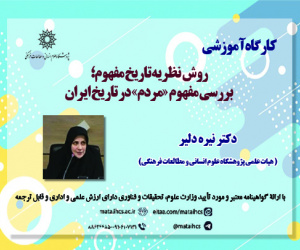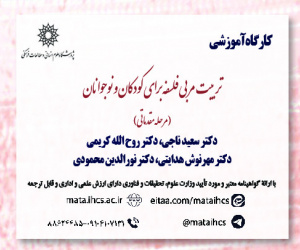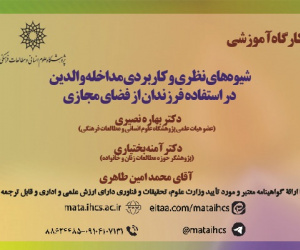مفهوم ابسنس در عکس های خصوصی تخریب شده: تکمیل روایت های عکاسانه (مقاله علمی وزارت علوم)
درجه علمی: نشریه علمی (وزارت علوم)
آرشیو
چکیده
از پیوندهای عمیق عکاسی با مقوله ابسنس (غیاب)، در حوزه عکس های خصوصی و خانوادگی دیده می شود. ماهیت عکس های خصوصی مبتنی است بر خاطرات زندگی نامه ای افراد و مخاطبان خاص عکس ها و بنابراین، این دسته از آثار در هنگامه تفسیر و تأویل همواره با کنش ها و واکنش های خارج از قاب توسط مخاطب خود همراهند. بسیاری از عکس ها به دلایل مختلف دچار خرابی می شوند از شرایط نامطلوب نگهداری گرفته که موجب تخریب فیزیکیِ آن میشود، تا پارگی و حذف شدگی تعمدی، که با انگیزه های شخصی صورت می گیرد. کارکرد ابسنس در خوانش های مبتنی بر خاطرات و روایت های شخصی پیرامون عکس خواهد بود. از آن جا که این دسته از آثار عکاسانه بسیار بر تفسیرها و تحلیل های شفاهی وابسته اند، می توان از روش تاریخ شفاهی به تحلیل جایگاه ابسنس در تکمیل روایت های عکاسانه در برابر عکس های خصوصی پرداخت. سوال این جاست که یک عکس قدیمی مخدوش، پاره شده و یا حتی به کلی نابود شده چگونه می تواند در خلق روایت های امروزین خود شرکت کند؟ در روند تحقیق حاضر به این نتیجه می رسیم که ابسنس کلیدی ترین عنصر در روایت های شفاهیِ عکس های خصوصی است. چرا که عناصر غایب در متن عکس، آزادانه تر در ساخت روایت ذهنی در حافظه ی مخاطب شرکت کرده، آن را بازسازی نموده و حس همدلیِ عمیق تری را در مخاطب خود نسبت به مصداق برمی انگیزند.The concept of absence in damaged private photographs: Completing photographic narratives
Statement of the Problem: One example of the profound connection between photography and the concept of absence is seen in private and family photographs. The nature of private photographs is based on the autobiographical memories of their viewers. Therefore, this category of works is always accompanied by actions and reactions that occur outside the frame of the photograph and by the viewer during interpretation. Many photographs become damaged for various reasons (such as unfavorable storage conditions leading to physical degradation, or deliberate tearing and removal, motivated by personal reasons). The function of absence in reviewing personal memories and narratives around the photograph is significant. Absence in private photographs refers to a range of factors and elements that can include anything affecting the narrative context the photograph provides, altering, distorting, or understanding the absence. Some examples include:
a) From physical changes in the photograph caused by the passage of time (aging, fading, surface damage) to cuts, tears, behind-the-camera events, and anything intentionally left out of the two-dimensional frame, but remains hidden and enduring in the viewer's mind. In the presence of a private photograph, the focus shifts from the object to the autobiographical memories of the subject the photograph represents. This interaction creates a dialogue between the photograph and the viewer, helping them understand how the meaning of the photograph has changed over time, akin to the change like the photograph’s tears and damage. In response to such an absence within the photograph’s text, which exists as a memory in the viewer's mind, a "wow moment" occurs, fundamentally based on absence and the physical deterioration of the photograph (consider a photo of two close family members, where for some reason in the past, the photo has been torn and the second person removed from the frame). Additionally, this "wow moment" can be caused by mental factors and the function of memory, inducing intense emotions such as sadness, distress, and sudden excitement in the viewer. Photography, memory, and absence form an integrated triad that can lead to a deeper understanding when contemplating private photographs. Photography has the capacity to establish a connection between time, duration, and daily life, acting as a mediator between visual traces and the expression of the experiential sense of absence. In this way, photographs and their inherent absence are among the factors that can eventually create a biographical memory over time.
b) Over time, changes occur in the viewer's mental perceptions, leading to other distortions and reconstructions: forgetting, changes in beliefs and attitudes, increasing information about the subject represented by the photograph, and similar factors. These can all lead to the distortion or change of the photograph’s meaning, even when a family photo is placed within an old album. This creates a narrativity of the photograph through the absence of historical elements. Generally, in viewing private photographs and family albums, the moment of contemplation before the photograph is brief, but the ensuing thoughts persist in the mind. Roland Barthes explains that it is enough to show your photos to someone, and they will immediately show you theirs: look, this is my brother, this is me as a child, and things like that. A photograph is nothing but a sequence of stages: look, see, here it is! Thus, before any private photograph, it is more the flood of autobiographical memories rather than its visual details that engage the viewer. After seeing the photo, the viewer revisits those memories, discussing them and the lived life, and the cherished subject of the photograph. Any form of absence created in the visual elements and forms within the photograph does not destroy its narrativity but rather completes it. Many spouses, after divorce, tear up shared photos to avoid seeing their ex-partner’s face in the photo post-separation. They later do not even look at the torn photo because the torn photo reveals the absence of the partner even more and resurrects deeper emotional and sentimental narratives, causing a sudden shock or jolt. Absence here also appears as a key element of the narrative.
Thus, it can be said that absence is always understood through individual self-awareness. It persists through the mutual interaction before the photograph and ultimately leads to the reconstruction of autobiographical memories and new narratives of past times and places. Narratives to which our identity and the photograph are bound; because the time and place shown by the photographs (much like the physical deterioration of the photograph) no longer exist today, but our body has experienced that particular place and time, remembered its narratives, and formed our identity over time.
c) Sometimes, certain photographs remain hidden from view for various reasons and are not displayed. Occasionally, during significant life events where photography is typically conducted, no photos are taken for various reasons. In these cases, the trace of absence can still be observed, continuing to shape various photographic narratives. In these cases, the physical absence of the photograph creates a powerful force in recalling and constructing implicit narratives. This function of the photograph is termed haunting.
Research Question: The question here is: how can an old, damaged, torn photograph, or one that has been completely destroyed, participate in creating contemporary narratives?
Research Methodology: Since the interpretation of private and family photographs relies on oral interpretations and analyses, the oral history method can be used to analyze the role of absence in the evolution of photographic narratives. Oral history comprises a collection of memories, quotes, and stories that occurred in specific situations for individuals, possessing unique and singular characteristics for the narrator, as they were an eyewitness to the events. Therefore, many researchers use this method of studying historical documents to develop social justice.
Research Findings: The present study concludes that absence is the key element in the oral narratives of private and family photographs. Because the absent elements in the photograph’s text more freely participate in the production of the mental narrative, reconstructing it, and thus creating a deeper empathy in the viewer. Any absence in the photograph’s text (whether primary absence or secondary absence) leads to the creation of emotional narratives before the photograph and the represented subject. Absence, through the damaged or destroyed photograph, and by stimulating the viewer’s emotions and feelings, creates a triad that ultimately, in a performance, employs all performance factors to evoke oral narratives before the photograph. The element of absence, at first, links the time and place of the photograph with the present moment of the viewer in an ontological manner, connecting the "there-then" of the photograph to the "here-now" of the viewer; secondly, it creates a phenomenological understanding of the viewer's embodiment, testifying that the subject represented by the photograph is not the same body the viewer knows and understands. Rather, it is a body that is narrative and has been accumulated with memories over many years. Here, if the photograph is damaged or deteriorated, absence becomes more actively involved in the cognitive process and further facilitates the creation of oral narratives. Additionally, it triggers embodied emotional, sentimental, or psychological reactions before the photograph (e.g., hugging the photo frame, touching its surface, experiencing excitement, sadness, mourning, and a sense of loss). Thirdly, it results in the execution of the narrative, which is the most important functional aspect of absence before private photographs, especially those that suffer from some kind of loss, such as damage, tearing, or deletion. An excellent example of this function of absence can be seen in Roland Barthes' book Camera Lucida. Camera Lucida is filled with peripheral discussions and implicit narratives about the photograph. Ultimately, the essence of absence transforms the oral narratives created before the photograph into a communicative medium between the viewer and others (or the viewer and the private photograph), thereby completing a form of oral history.






